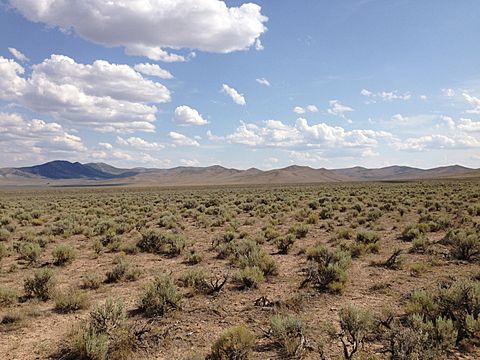Great Basin Floristic Province facts for kids
The Great Basin Floristic Province is a special area defined by the types of plants that grow there. It's like a huge natural plant community! This region is part of a larger plant kingdom called the Boreal Kingdom. You can find it in the Western United States.
Contents
What is a Floristic Province?
A floristic province is a large part of the world where the plants are quite similar. Think of it as a giant plant neighborhood! Scientists use these areas to understand how plants are spread across the Earth.
Two important scientists, Ronald Good (in 1947) and Armen Takhtajan (in 1986), helped define these areas. They looked at which plants naturally grow together. This helps us see how different parts of the world are connected through their plant life.
Where is the Great Basin Floristic Province?
The Great Basin Floristic Province covers a large area in the Western United States. It's bigger than just the "Great Basin" area you might hear about for water drainage. This plant province includes several other interesting places.
It stretches to include the Snake River Plain and the Colorado Plateau. It also covers the Uinta Basin and parts of Arizona. These parts of Arizona are found north of the Mogollon Rim.
Special Plants of the Great Basin
What makes the Great Basin Floristic Province unique? It's known for certain types of plants that grow there. The most famous is the Great Basin sagebrush (Artemisia tridentata). You'll see lots of it if you visit!
Another important group of plants found here are the saltbushes. These plants belong to a group called Atriplex. They are very good at growing in salty soils, which are common in parts of the Great Basin.
Other Ways to Divide the Region
Scientists sometimes divide the Intermountain West into different regions. This helps them study the environment in various ways. The Great Basin Floristic Province is one way to do this, focusing on plants.
Other groups also have their own ways of dividing the land. For example, the U.S. Environmental Protection Agency (EPA) has its own "ecoregions." These include the Central Basin and Range ecoregion and the Northern Basin and Range ecoregion.
The World Wildlife Fund (WWF) also has its own classifications. They talk about the Great Basin shrub steppe and Great Basin montane forests. All these different ways help us understand the unique nature of this region.
Deserts of the Great Basin Province
Within the Great Basin Floristic Province, you'll find some large deserts. These deserts are important parts of the landscape.
- The Great Basin Desert covers about 39,505 square miles (102,318 square kilometers) in Nevada.
- The Great Salt Lake Desert is about 4,000 square miles (10,360 square kilometers) in Utah.
- The Escalante Desert is another desert in Utah, covering about 3,270 square miles (8,470 square kilometers).
These deserts are home to many of the special plants and animals that define the Great Basin Floristic Province.


